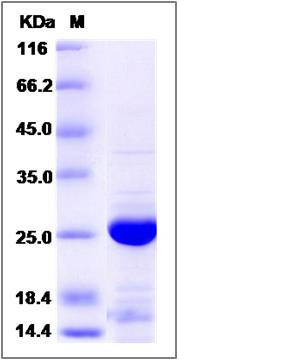Human COMMD9 Protein (His Tag)
HSPC166
- 100ug (NPP3756) Please inquiry
| Catalog Number | P14570-H07E |
|---|---|
| Organism Species | Human |
| Host | E. coli |
| Synonyms | HSPC166 |
| Molecular Weight | The recombinant human COMMD9 consists of 213 amino acids and predicts a molecular mass of 23.7 KDa. It migrates as an approximately 25 KDa band in SDS-PAGE under reducing conditions. |
| predicted N | His |
| SDS-PAGE |  |
| Purity | > 85 % as determined by SDS-PAGE |
| Protein Construction | A DNA sequence encoding the human COMMD9 (Q9P000-1) (Met1-Lys198) was expressed with a polyhistidine tag at the N-terminus. |
| Bio-activity | |
| Research Area | |
| Formulation | Lyophilized from sterile PBS, 10% Glycerol, pH 8.0. 1. Normally 5 % - 8 % trehalose and mannitol are added as protectants before lyophilization. Specific concentrations are included in the hardcopy of COA. |
| Background | COMMD9 is a COMM domain-containing or COMMD protein. COMMD family is comprised of ten members which are widely conserved throughout evolution and share certain functional properties. They represent a recently discovered set of evolutionarily conserved factors characterized by the presence of a defining carboxy-terminal motif. COMMD protein functions in the control of the transcription factor NFkappaB. NFkappaB plays a critical role in a number of homeostatic processes in multicellular organisms, including the regulation of immunity and cell survival. COMMD proteins inhibit NFkappaB mediated gene expression, and recent mechanistic studies have revealed that COMMD1 controls the ubiquitination of NFkappaB subunits, an event linked to transcriptional termination. COMMD1 binds to a multimeric ubiquitin ligase containing Elongins B/C, Cul2 and SOCS1 (ECS( SOCS1)). In this complex, COMMD1 facilitates the binding of NFkappaB subunits to the ligase, thereby promoting their ubiquitination and degradation. Additional insights gained from these studies indicate that COMMD proteins likely play a broader role in cellular homeostasis through their participation in the ubiquitination pathway. |
| Reference |
